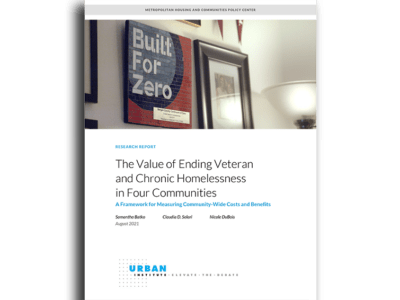Yesterday, the United States Interagency Council on Homelessness released All In: The Federal Strategic Plan to Prevent and End Homelessness. In it, the Biden-Harris Administration set an ambitious and important goal to “reduce homelessness by 25% by January 2025 and set us on a path to end homelessness for all Americans.”
Community Solutions supports this plan and applauds that its goal reflects the urgent need to equitably reduce homelessness and the human suffering that results from it. The ambitions of this aim rise to meet the degree to which the lives of our most marginalized neighbors are at stake.
We believe that achieving this goal is not only necessary, but possible. As VA Secretary Denis R. McDonough and HUD Secretary Marcia L. Fudge note: “Homelessness is solvable. We know this because we have seen it done.” We witness every day the commitment of communities across the country working to drive toward zero in homelessness.
Communities are demonstrating there is a roadmap for making progress. As an organization, we support Built for Zero, a national network of 105 communities across the United States working to make homelessness rare and brief. These cities and counties — of all types — measure progress by whether they are driving homelessness toward functional zero and are working on creating racially equitable homeless response systems. Through this diverse movement, we are aware of the challenges that stand in the way and the catalytic opportunities we can seize.
By working collectively to reduce homelessness, we can make measurable progress. The federal strategic plan is wisely built around three foundational pillars — equity, data, and collaboration — and three solution pillars — housing and supports, homelessness response, and prevention. We all have a role to play. In this piece, we have focused on a selection of policies and strategies related to these pillars where we can offer additional insight and actions that should be considered to help us collectively accelerate and scale reductions in homelessness, everywhere.
The Biden-Harris Administration set an interim goal to reduce homelessness by 25% by January 2025 and encouraged states and local governments to set population reduction goals for 2025.
Insights
We have observed that beginning with a shared aim for solving homelessness that is clear, objective, and measurable is a powerful step toward reducing homelessness. This often marks the beginning of establishing an effective community-wide team and creating shared accountability for measurably reducing homelessness.
Data and information sharing
The plan commits to strengthening the capacity of state and local governments, territories, tribes, Native-serving organizations operating off tribal lands, and nonprofits to collect, report, and use data.
Insights
This strategy has the opportunity to accelerate and catalyze change in communities, and we are eager to see and support the operational plans. Communities have demonstrated that quality data is both a prerequisite and an accelerant for reducing homelessness anywhere. Using comprehensive, real-time, person-specific data, cities and counties have been able to deliver tailored solutions for unhoused neighbors, accelerate housing placements, make targeted system improvements, and drive equitable reductions in overall homelessness. While communities have demonstrated the power of maintaining and using quality by-name data, they have also shared that they depend on technology systems that do not provide the functionality or the comprehensive data they need.
The plan also recognizes the importance of improving information-sharing with public and private organizations at the federal, state, and local level.
Insights
This strategic plan recognizes that ending homelessness is not the task of a single sector, but the work of an entire community. We appreciate the plan’s understanding that data interoperability — and being able to share appropriately protected data — is one of the first steps to enabling effective collaboration. Communities often cannot facilitate the collaboration, shared accountability, and problem-solving needed to drive reductions in homelessness if actors outside of the immediate homeless response system cannot access the real-time, person-specific data they need.
Equity
The plan notes the intention to ensure that federal efforts to prevent and end homelessness promote equity and equitable outcomes.
Insights
We applaud this focus on equity, which matches the desire we’ve heard from local leaders to address disparities in their homeless systems. In response, we worked with local homeless services leaders and people who experienced homelessness to develop a framework for understanding and improving the equity of a community’s homeless response system, beginning with a focus on race. With support from 11 external partners, four Built for Zero community teams, and three focus groups of people with lived experience of homelessness, we developed a measurement framework to support communities in designing and measuring a racially equitable homeless response system.
Improve effectiveness of homelessness response systems
Insights
Strategies focused on improving technical interventions and programs are an important part of helping communities reduce homelessness. Through our work, we have found that translating effective programs into population-level reductions also requires skilled expertise and dedicated capacity for systems improvement. Without this capacity, communities are unable to track whether their interventions and programs are adding up to population-level reductions in homelessness. Communities that are primed to make progress have been equipped with problem-solving tools and capacity like data analytics, quality improvement, and human-centered design. With these disciplines, communities have been able to dynamically improve their homelessness response systems overall and achieve measurable reductions in homelessness. Across many communities, we have found that new resources are only as effective as a local team’s ability to implement them as part of a well-coordinated system. We are in the process of testing the most high-impact ways to invest in this implementation capacity directly in communities.
Prevent homelessness
Insights
We applaud the federal strategic plan’s explicit focus on targeting inflow in order to reduce overall homelessness. As part of our support of communities, we saw that prevention efforts were often not well-targeted and not necessarily resulting in fewer people entering the homeless response system. This highlighted a critical need to create connection and accountability between prevention efforts in upstream systems with inflow into the homeless response system. Part of the challenge, however, is that agreements, policies, or structures are rarely in place to make inflow into homelessness a measure of accountability for upstream systems. In several communities, we have begun testing new ways of working with upstream systems like health care, public health, and the Department of Corrections to reduce inflow into homelessness.
Scale housing and supports that meet demand
The federal strategic plan incorporates a strategy for maximizing the use of existing federal housing assistance.
Insights
We appreciate the focus on leveraging all resources in a community to combat homelessness and look forward to an implementation strategy that eliminates barriers to housing and improves housing access for all people to ensure the fidelity of Housing First. Our experience affirms that there are significant opportunities to accelerate reductions in homelessness by maximizing the use of existing federal, state, and local resources. Communities with coordinated, streamlined housing placement processes supported by quality data have reduced homelessness at the population level, even while pressing for needed new supply. A focus on the optimal use of existing resources extends to properties as well. Communities — including several we have directly assisted — have acquired existing privately owned rental housing to preserve affordable housing and create immediate opportunities to house those transitioning from homelessness as vacancies occur. Finally, we appreciate that the plan’s focus on landlord engagement points to the necessity of positioning homelessness as a measure of effective housing policies at every level. Communities that have mobilized their private sector developers, property owners, and managers as part of a shared goal of ending homelessness are making measurable progress.
The plan notes that the federal government should do whatever it can to expand engagement, resources, and incentives to spur the creation of new supportive and affordable housing while encouraging states, localities, and territories to review and adjust their own policies.
Insights
We applaud the focus on facilitating city and state updates of zoning laws and policies, which would allow for the preservation and creation of affordable housing and address barriers that have restricted equitable access to housing. We have learned from rural communities in our network that the United States Department of Agriculture could play an expanded role in spurring the creation of supportive and affordable rental housing designed for rural contexts.




